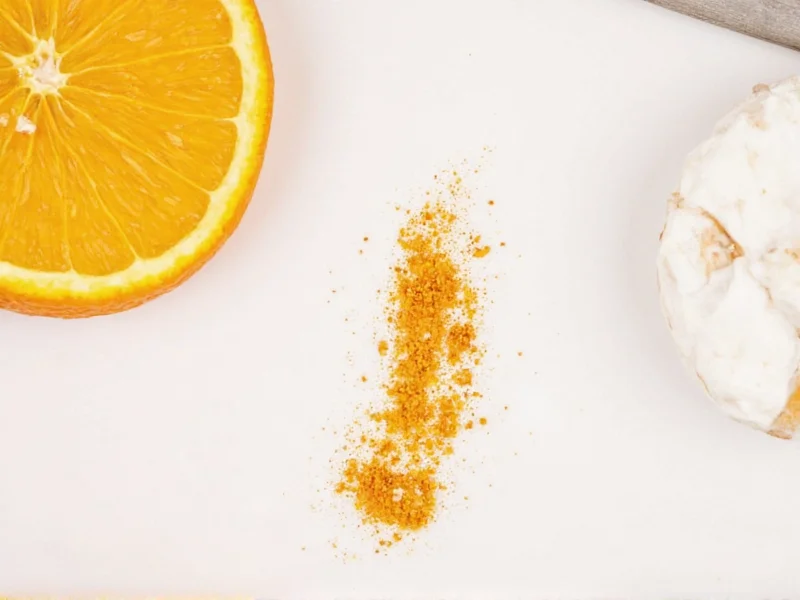When you're in the middle of preparing a recipe and realize you're out of orange zest, knowing reliable alternatives can save your dish. Orange zest provides concentrated citrus flavor and aromatic oils that significantly impact both sweet and savory recipes. Understanding proper substitution ratios and flavor profiles ensures your culinary creation maintains its intended character.
Why Orange Zest Matters in Cooking
Orange zest contains essential oils in the fruit's outer peel that deliver intense citrus flavor without the liquid or acidity of juice. These oils contain limonene and other compounds that provide bright, aromatic notes essential to many recipes. Unlike juice, zest adds flavor without altering moisture content—critical in baking where precise liquid ratios matter.
Top Substitutions for Orange Zest
Each alternative brings unique characteristics. Consider your recipe type when choosing:
| Substitute | Ratio | Best For | Flavor Notes |
|---|---|---|---|
| Lemon zest | ¾ the amount of orange zest | Baking, marinades | More tart, less sweet citrus profile |
| Orange extract | 1 tsp per 1 tbsp zest | Baking, frostings | Concentrated flavor, no moisture |
| Orange juice | 2 tbsp per 1 tbsp zest | Sauces, syrups | Adds liquid, milder flavor |
| Tangerine zest | 1:1 replacement | Desserts, salads | Sweeter, less bitter alternative |
| Orange oil | ¼ tsp per 1 tbsp zest | Professional baking | Most concentrated option |
Using Lemon Zest as Orange Zest Substitute
Lemon zest serves as the most accessible alternative when orange zest isn't available. The flavor profile differs—lemon offers brighter acidity while orange provides sweeter notes. When substituting lemon zest for orange zest:
- Use ¾ the amount specified for orange zest to prevent overpowering tartness
- Add ⅛ teaspoon sugar to recipes to balance increased acidity
- Works exceptionally well in pound cakes, shortbread, and fish marinades
This substitution for baking with citrus works particularly well when combined with a small amount of orange juice to recapture some sweetness.
Extracts and Oils: Concentrated Alternatives
Orange extract provides the most direct flavor replacement without adding moisture. When using extracts as orange zest alternatives:
- Choose pure orange extract rather than artificial varieties for authentic flavor
- Remember that 1 teaspoon extract equals approximately 1 tablespoon fresh zest
- Add extracts toward the end of mixing to preserve volatile flavor compounds
For professional results, orange oil offers even more concentrated flavor—use just ¼ teaspoon oil per tablespoon of zest. This substitution works best in recipes where minimal liquid addition matters, such as macarons or delicate pastries.
Juice-Based Substitutions and Their Impact
When using orange juice as a substitute for orange zest, understand you're adding liquid to your recipe. This works well in:
- Glazes and sauces where additional moisture benefits texture
- Marinades that benefit from citrus acidity
- Recipes already containing significant liquid ingredients
Use 2 tablespoons juice per 1 tablespoon zest, and reduce other liquids by 1 tablespoon to maintain proper consistency. This citrus zest replacement works particularly well in vinaigrettes and braising liquids but requires adjustment in baked goods.
Special Considerations for Different Recipes
The best substitution varies by application:
Baking Applications
In cakes, cookies, and breads, maintaining proper moisture balance is critical. For baking substitutions for orange zest:
- Use zest alternatives that don't add extra liquid when possible
- Consider combining ½ teaspoon extract with 1 teaspoon juice for balanced flavor
- Avoid juice-only substitutions in recipes with precise liquid ratios
Savory Dishes and Marinades
For chicken, fish, or vegetable preparations:
- Lemon zest works exceptionally well as a substitute for orange zest in savory applications
- Add complementary herbs like thyme or rosemary to enhance the citrus notes
- Consider using preserved orange peel in Middle Eastern or Moroccan dishes
Common Substitution Mistakes to Avoid
Even experienced cooks make these errors when replacing orange zest:
- Using the white pith along with zest (creates bitterness)
- Substituting equal amounts of juice for zest without adjusting other liquids
- Using artificial flavorings that create chemical aftertastes
- Not adjusting sugar levels when using more acidic alternatives
Remember that dried orange peel requires rehydration and provides less intense flavor—use 1 teaspoon dried for every tablespoon fresh zest, steeped in warm liquid for 10 minutes before use.
Creating Your Own Citrus Flavor Profiles
When perfect substitutes aren't available, create custom blends:
- Mix lemon and tangerine zest (½ + ½) for balanced orange-like flavor
- Combine ¾ teaspoon lemon zest with 2 tablespoons orange juice
- Add a pinch of ground coriander to lemon zest for complex notes
These creative substitutions for orange zest work particularly well in recipes where exact flavor replication isn't critical, such as in compotes or infused syrups.
Storing Citrus for Future Zesting
Prevent future substitution needs by properly storing citrus:
- Freeze whole oranges for up to 6 months, then zest while partially frozen
- Store zested oranges in airtight containers for juice use
- Preserve excess zest in olive oil for savory applications
Having frozen citrus available eliminates the need for substitutions when recipes specifically call for fresh zest.











 浙公网安备
33010002000092号
浙公网安备
33010002000092号 浙B2-20120091-4
浙B2-20120091-4